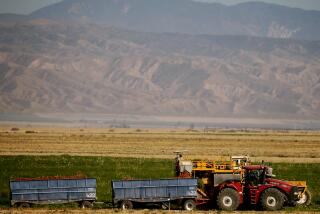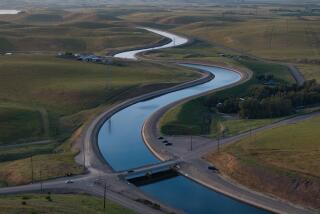State Faces Price Haggle in Search for Water : Drought: Only 25% of the amount sought for an emergency bank has been contracted for. Some farmers reportedly want twice the money being offered.
State officials shopping for water to place in an emergency drought bank have captured just one-fourth of the amount they consider vital to meeting the critical needs of Californians during the fifth year of drought, the deputy director of the Department of Water Resources said Tuesday.
Bob Potter said contracts for the purchase of 250,000 acre-feet of water have been negotiated by the state since Gov. Pete Wilson ordered the creation of a centralized water bank to aid drought-ravaged regions.
Skeptics said the figure confirms their prediction that the state is not offering enough money to persuade wary farmers to sell their water rather than plant a crop this year. Potter said he remains confident that the bank will reach its goal of collecting 1 million acre-feet of water for needy customers.
âMy sense of it is that weâre doing very well,â Potter said. âThere is still time left and we are generating new contracts as fast as we can review them.â
Negotiations aimed at securing another 300,000 acre-feet of water for the bank look âpromising,â Potter noted, and the recent storms in Northern California have put âquite a bit of water into the system,â an influx that could reduce demand for the emergency supplies.
Given those factors, Potter said, there was âno needâ to stimulate interest in the bank by raising the $125 per acre-foot the state is offering for water in this unusually dry year.
Despite such optimism, attorneys representing rice-growing districts, which control large supplies of water that are coveted by the state, said farmers will not sell at the current price.
âThere are growers willing to idle their land and lay off their employees if it means helping an urban area that is in trouble,â said Paul Minasian, an Oroville lawyer whose firm represents 50 Northern California water districts. âBut the prevalent view here is they wonât do it for that price the state seems so insistent on.â
Minasian said many rice growers favor a price of $250 to $300 per acre-foot, or 326,000 gallons, an amount that they say they would share with idled workers and support industries hurt by a decline in farming.
Meanwhile, buyers waiting anxiously to withdraw from the water bank lamented the scarce amount of water pooled and accused would-be sellers of demanding unreasonable prices during a time of emergency.
âIt seems to me there is a need for some . . . responsible action on the part of those who have water to make it available at a reasonable price like the governor has encouraged,â said Duane Georgeson, assistant general manager of the Metropolitan Water District, which hopes to buy 350,000 acre-feet from the bank. Holding out for higher prices, he added, âsounds like profiteering.â
At some point, Georgeson said, âthere could be a need for the governor to exercise his authority to ensure that both the sellers as well as the buyers are acting responsibly.â
Some water-strapped regions have been hunting for supplies on their own. Wilson and other state officials have counseled against such an approach, fearful that competitors offering to pay more for water would jeopardize the bankâs success. But some areas are desperate.
In western Kern County, the Berrenda Mesa Water District has 30,000 acres of trees and vines that are threatened because the areaâs only supply of water--the State Water Project--was eliminated this year. The district has appealed to potential sellers through advertisements in Northern California newspapers.
Although some minor water transfers occurred in the past drought, Gov. Wilsonâs decision to create an emergency bank for the large-scale shipment of water from the haves to the have-nots is unprecedented. The action was encouraged by the MWD and others as a way to coordinate an orderly transfer of water and ensure that all areas get enough to survive.
Following a formula being developed, the governor will soon begin parceling out water purchased by the state to needy cities and farm belts, which will reimburse the state for the cost of the water and administrative fees. Buyers will also pay the transportation costs of moving the water.
Under the novel program, farmers can sell to the bank in one of several ways: They can fallow their land and sell river water normally used on crops, sell their portion of river water and instead pump ground water to irrigate farmland, or sell their ground water by pumping it directly into the river system.
So far, most of the contracts have centered on the sale of surface water. Deals that involve ground water are generating controversy in several counties because of fears that the pumping will overtax underground supplies.
In Yolo County, a large ranch planning to sell up to 50,000 acre-feet of its Sacramento River water and continue farming with the use of ground water alarmed the Board of Supervisors, which reached an agreement limiting the amount of water the farmers could pump.
Potter acknowledged that ground water is a sensitive issue and said the state is âaddressing the concerns of the countiesâ and discussing plans for a program to monitor the level of underground supplies.
More to Read
Sign up for Essential California
The most important California stories and recommendations in your inbox every morning.
You may occasionally receive promotional content from the Los Angeles Times.










